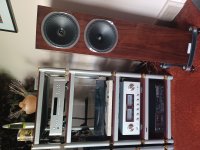Just a note that all hard materials, including tile, stone, concrete, will resonate, and or, ring. Just ask the folks who were walking down Market Street in San Francisco in 1906. In fact, sound waves will travel faster through concrete than air because it's much denser.
Folks that think having a concrete slab floor means it won't vibrate, resonate, ring, or have an audible impact on the sound of their system should...think again.
Here's some...data: Watch this video with Norm Varney of A/V Roomsystems, play a music box mechanism at approx. 8:20 into this video, and specifically, on a speaker with a cabinet made of concrete at approx. 13:10 into the video. Turns out concrete rings like a bell.
This is why racks (e.g, Core Audio, HRS, Finite Elemente, Artesania), amp stands, speaker cabinets that incorporate constrained-layer damping (as one example of a design embodiment) perform well to attenuate or damp (not "dampen", which is to make something moist) vibration, resonances, and ringing.

